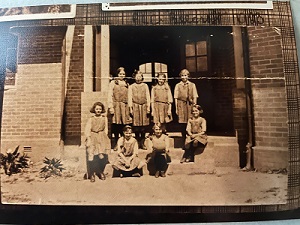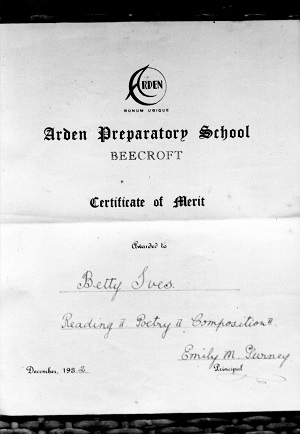Arden Anglican School
Arden Anglican School at Beecroft (as it is now known) can trace its origins to a school that commenced in Beecroft in 1922 as a preparatory school for the Presbyterian Ladies’ College, Croydon.

Following the conclusion of the First World War, the Presbyterian Church of New South Wales had taken a number of steps to attract more young people into its congregations and one of the ways it sought to do this was to establish Presbyterian schools. These schools were said to be “regarded as much-vaunted symbols of success in an otherwise lacklustre church.’ Presbyterian schools were around this time established in Goulburn, Knox College at Wahroonga or approved like a boy’s school in Armidale in addition to that in Beecroft [1].
Dr Samuel Angus, was Professor of New Testament at the Theological Hall, part of St Andrews College, University of Sydney keenly pursued this initiative. This was assisted by his role entitling him to membership of Presbyterian school councils and a friendship with Mr Robert Winton Gillespie who, apart from being a leading company director in Sydney was the founding Chairman of Knox Grammar School and from 1923 the Chairman of the Council of Presbyterian Ladies College, Sydney [2]. Within Beecroft, the Presbyterian Minister Rev A M Ogilvie had since his appointment to that role pursued an interest in encouraging work with youth.
While the Presbyterian Ladies College had established a school at Pymble in 1916, and Goulburn in 1921 there had, at the same time, been some discussion at the school council about the need for a preparatory school along the northern railway line. None of these ideas were pursued until on 23 February 1922 a deputation to Council was received from the Beecroft Presbyterian Church. The deputation comprised Rev Ogilvie and Messrs Vicars (also a member of the PLC Council) and Nathan (a youth leader in Beecroft) and Mrs Holt (wife of local Beecroft doctor). The Council appointed a sub-committee to look into the proposal. The sub-committee comprised Dr Angus, the Minister at Roseville and the Principal of the College. The sub-committee report was presented by Dr Angus at the March meeting and discussed three possible sites – the Herman property (Ramona) in Beecroft [3], Etridge House in Pennant Hills [4] and the Beecroft Presbyterian church hall. Mr Robert Vicars also offered the Council an interest free loan of 1,500 pounds for 3 years to assist with the purchase of a property [5].
Rather than purchase, the Council elected to rent the Beecroft Church hall. With remarkable alacrity for any committee, at the April meeting of the Council Dr Angus reported that Mrs Eleanor Linck had been appointed as teacher-in-charge at an annual salary of 225 pounds, the hall leased for 1 pound per week and 13 pupils enrolled [6].
Mrs Eleanor Linck had previously taught in England [7]. At the school’s first prize giving in December 1922, the prizes were presented (and an address delivered) by Dr Samuel Angus of St Andrews College, University of Sydney. In 1922 the full student population comprised Betty Craig, Ina Fennell, Jean Hall, Nancy Holt, Denise Hull, Ruth Layton, Brenda Linck, Adria Nathan, Betty Nossiter, Peggy Seale, Greta Taylor, Janet Vicars and Margaret Vicars [8]. Dr Angus returned in 1925, when it was noted that the Professor had been ‘closely connected with the school at its commencement’ [9]. By 1923 there were 49 students but it was still not financially viable – noting that in 1926 to 1929 the main school at Croydon was also running a deficit [10]. Despite having a small school population it had an Old Girls Union from at least 1926 [11]. The lack of financial viability seems to have been, at least in part by the failure of the School Council to support Mrs Linck’s proposals to expand the school into its own premises. Her proposals had been supported by growing enrolments. In 1924 Ramona was still for sale and she again promoted it as a possible site for the school. Later she suggested to the PLC Council that the house next to the hall be purchased as a boarding house. The Council minutes do not record action in response to either action although it is noted that Ramona was sold elsewhere. In 1926, the PLC Principal and Mr Robert Vicars as a PLC School Councillor, again moved that a neighbouring property be purchased. The Council appointed a Committee to report but no report of the Committee can be found in the Council minutes. In that same year, Mrs Linck resigned to take up a position at PLC Melbourne and in 1928 became the principal of a new school called Orange Presbyterian Ladies College [12].
In 1925 a second teacher was engaged. This was Miss Jean Nossiter. Nossiter was a local girl living in Jenanbee no.5 The Boulevard, Cheltenham. Her parents were actively involved in local affairs.
Mrs Lucy I Ritter became the second Head. In her 1927 report to Council Mrs Ritter stated that “Beecroft deserves more support from Presbyterians on the Hornsby line.” On 19 June 1929 the Council resolved to close the school and Mrs Ritter [13] and her assistant teacher Miss Gurney resigned in December of that year [14].
The Principal of PLC Sydney was invited to resign and in his farewell speech included a comment “that as the Council’s only aim in education was to make money and as he had not made money for them they were quite right in dismissing him” [15].

Miss Emily Gurney (the former assistant teacher) leased the Church hall in 1930 and opened a school there, which she called ‘Arden,’ as the leafy surroundings of Beecroft reminded her of the Forest of Arden from Shakespeare’s play As You Like It [16]. By 1933 it was registered to cover the full primary curriculum.
The School house system was introduced by Miss Gurney. She named the first two houses as after forests, consistent with the school being called Arden, Sherwood and Birnam – the latter derived from Shakespeare’s Macbeth. The house colours were respectively blue and red. As enrolments increased in the 1960s a third house was introduced and was called Jenolan after a State forest at Oberon and having its first letter, J, being half way between S and B. Its colour was initially purple (a mix of blue and red) but later changed to yellow [17].
When Miss L. Windridge took over as principal in 1939 the school was again in financial difficulty and under threat of closure. Miss Windridge approached Canon Roderick Johnstone, the Rector of St John’s Beecroft, and a member of the Council for the Promotion of Sydney Church of England Diocesan Schools, who had expressed the idea that there should be a Church of England school in the area. The Council took over and managed the school. So in 1946, Arden Church of England Girls’ School was established and moved to St John’s Anglican Church, occupying the Sunday School Hall. It was not until 1952 that Arden established itself at 39 Railway Parade, later renamed Wongala Crescent, with the purchase of Nelson House assisted by a gift of three thousand pounds from Mr C.O.Nelson. However, the school continued to have problems in attracting numbers and retaining principals and the Diocesan Council resolved to close the school at the end of 1959, concerned that it was in debt. This was rescinded due to the determination of Canon Johnstone and the parent body. The school became more firmly established with its own Council in 1962. Under the leadership of Miss M. Hudson (1965 – 1972) a high educational standard was a focus.
Miss Margaret Duckworth began a 20-year period as the first non-teaching Principal in 1972. During this time the school expanded, acquiring adjacent properties and undertaking a building program. Among the properties purchased was 63 Beecroft Road (Cook House) a notable Beecroft home designed by George Sydney Jones in 1909 as a home and medical practice. In 1981 another heritage house on Wongala Crescent (now Hudson House) was purchased. Boys were part of the school until grade 3 but since 1976 it has been entirely co-educational. Mr Colin May FACE, Principal 1992 – 2009, oversaw the opening of a secondary campus at Epping, when the former site of the Australian American International School in Oxford Street was purchased. Secondary classes began operation there in 2003. Also in 2008 a new senior campus was commenced in office buildings nearby in Epping. During his leadership the school undertook its greatest expansion. The first students studying to HSC level graduated in 2008.
Arden Anglican School is an institution based on strong Christian values, apparent in its motto ‘In God my joy’, and offering a co-educational program from pre-school to secondary. Of the many small private schools founded in Beecroft early in the 20th century, Arden is the only survivor.
Principals
1922-1926 Eleanor Linck
1927-1929 Lucy Ritter
1930-1939 Emily Gurney
1939- L Windridge
1965-1972 M Hudson
1972-1991 Margaret Duckworth
1992-2009 Colin May
2009- Graham Anderson
[1] S E Emilsen A Whiff of heresy: Samuel Angus and the Presbyterian Church in New South Wales (UNSW Press, Kensington, 1991) pp 102-3; Sydney Morning Herald 23 May 1923 p14.
[2] S E Emilsen A Whiff of heresy: Samuel Angus and the Presbyterian Church in New South Wales (UNSW Press, Kensington, 1991) pp 83, 92; J McFarlane The Golden Hope: Presbyterian Ladies College, Sydney 1888-1988 (Presbyterian Ladies College, Croydon, 1988) p 56
[3] the John Sands Directory entries for Beecroft and Cheltenham in 1922 do not refer to anyone by the name of Herman but there is the home of Gustav Heumann on Beecroft Road in Cheltenham and a Joseph Harman in Welham Street Beecroft. As the Council refers to a proposal for a school in Cheltenham, the proposal presumably refers to the Heumann property. The Heumann home was Ramona, one of the grand houses of the district and for which see elsewhere on this web site.
[4] Ettridge in Pennant Hills was the home of John Thomas Frederick Bull in Hampden Road, Pennant Hills. In 1924 this substantial home was sold to the Redemptorist Brothers as a monastery. See H Barker & M Elven Houses of Hornsby Shire Vol 1 The Large Houses (Hornsby Shire Historical Society, Hornsby, 1989) pp 100-102
[5] J McFarlane The Golden Hope: Presbyterian Ladies College, Sydney 1888-1988 (Presbyterian Ladies College, Croydon, 1988) p 58
[6] J McFarlane The Golden Hope: Presbyterian Ladies College, Sydney 1888-1988 (Presbyterian Ladies College, Croydon, 1988) p 59
[7] Tweed Daily 5 September 1922; Sydney Morning Herald 16 December 1922; Cumberland Argus and Fruit Growers Advocate 16 December 1922.
[8] Beecroft Briefly, May 1997.
[9] Sydney Morning Herald, 18 December 1922, p. 11; 8 October 1925, p.14
[10] J McFarlane The Golden Hope: Presbyterian Ladies College, Sydney 1888-1988 (Presbyterian Ladies College, Croydon, 1988) pp 68-71.
[11] Daily Telegraph 23 June 1926 p12
[12] Wellington Times 29 September 1927.
[13] In 1937, Mrs Ritter became Principal of Chelwood School, Ascot, Brisbane: Courier Mail 24 June 1937 p.11
[14] J McFarlane The Golden Hope: Presbyterian Ladies College, Sydney 1888-1988 (Presbyterian Ladies College, Croydon, 1988) pp 61-62
[15] quoted in J McFarlane The Golden Hope: Presbyterian Ladies College, Sydney 1888-1988 (Presbyterian Ladies College, Croydon, 1988) p 72.
[16] arden.nsw.edu.au/about-arden/history/ accessed 10 August 2021
[17] “The Houses at Arden” Arden Alumni Association 17 June 2021 accessed 20 July 2021.
.
